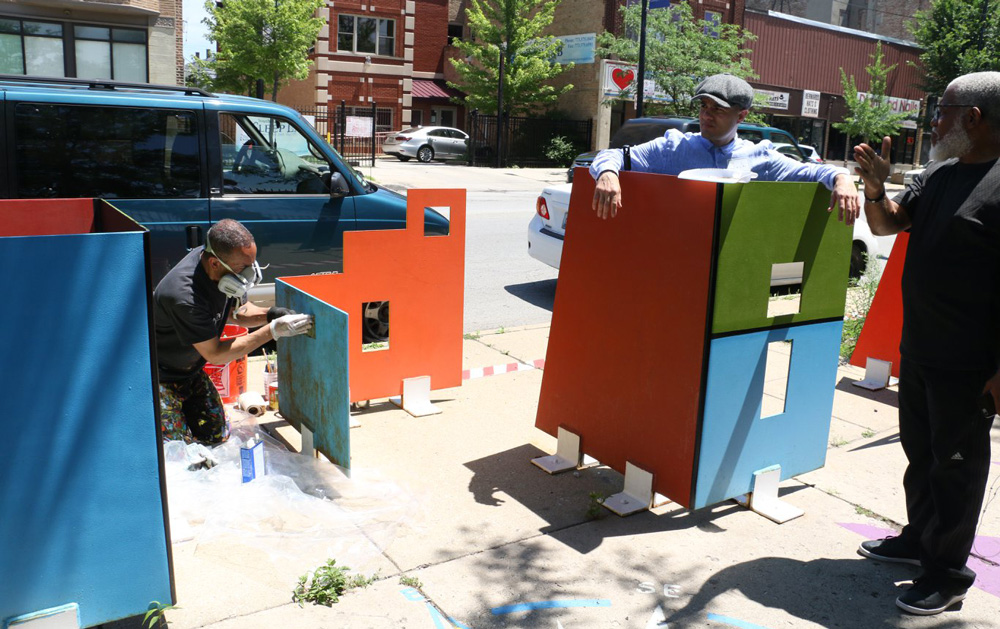An Invisible Asset: The Calumet River on Chicago’s Southeast Side
Written by Nicolas Robledo; edited by Choe Gurin-Sands
The Chicago Community Trust is currently funding ten community-led riverfront projects through their Our Great Rivers grant. This piece is the fifth of a ten-part series highlighting these projects.

Children playing at the Ewing St. Bridge site in South Chicago. Photo: Calumet Connect; Julia Hunter, Work2gether4peace
The Calumet River is an invisible asset to most residents on Chicago’s southeast side. It unites the entire Calumet Region under its economic umbrella of heavy industry, yet physically divides many of its neighborhoods and is generally inaccessible to residents.
Jackson Morsey, an urban planner with the Great Cities Institute (GCI) at the University of Illinois at Chicago (UIC), recalls that residents hardly interact with the river.
“The Calumet River is essentially invisible to the surrounding communities and has prevented residents from perceiving it as a community asset,” Morsey says.
GCI is part of the team that received a grant from the Chicago Community Trust to carry out the Calumet Connect project, a plan to better connect the southeast side communities to each other and to the Calumet River. The project team also includes the Alliance for the Great Lakes (A4GL), Claretian Associates, the Friends of the Parks (FotP), the Major Taylor Trail Cycling Club of Chicago (MTTC3), NeighborSpace, the South Chicago Chamber of Commerce (SC3), the Southeast Environmental Task Force (SETF), the South Worx Arte Group (SWAG), the Chicago Public Art Group (CPAG), the Illinois Public Health Institute, and the UIC College of Nursing.
The project is part of a continued effort by the partners above to bring more resources to the city’s long-neglected southeast side.
“There are three main goals in the Calumet Connect project: quality of life, recreation, and economic development,” said Morsey.

Photo: Great Cities Institute
Throughout the project, the team has been focused on building relationships and coalitions in the community.
“Our mission is to develop local capacity, empower communities to engage with their local governments and listen to what their fellow residents need to improve their communities,” said Morsey.
Another critical focus of Calumet Connect is public health. The heavily industrialized southeast side has had a long history of pollution and public health issues, most recently publicized by the outrage over the storage of toxic industrial materials such as petroleum coke (“petcoke”) and manganese in the nearby industrial corridor. Residents of Chicago’s southeast side successfully organized to ban the storage of petcoke in the city, and most recently, limit the storage of manganese.
Similar to the Chicago Sanitary & Ship Canal (the South Branch of the Chicago River), the Calumet riverfront continues to be dominated by industry. This adds an extra layer of complexity to the Calumet Connect project. The coalition recognizes this and actively works with community stakeholders to understand the neighborhoods’ desires surrounding the river.
“With nearly 13,000 jobs in the planned manufacturing district along the Calumet River, our hope is to not push the industry out, but find ways to promote cleaner, sustainable industries and adjust zoning where needed to prevent additional polluting industries from moving in,” said Morsey.

This art installation on Commercial Ave is designed to engage pedestrians in play. Photo: Calumet Connect; Julia Hunter, Work2gether4peace
This is a daunting task, and the Calumet Connect coalition is starting small. They will be hosting pop-up events through the summer of 2018 that will be aimed at helping local residents gain access to the Calumet River, some for the first time in their lives.
“At each pop-up event, we will have mini-charrette events to gather the participants ideas in a fun and informative way, and all residents will be invited to larger charrette events later in the summer to get more specific and regional feedback on what residents would like to see in terms of trail connections, land and water recreation opportunities and ideas for using the river for economic development” said Jack Rocha, another urban planner with the GCI team.
In the long-term, this project seeks to reconnect neighborhoods divided by the river and nearby Calumet Industrial Corridor, provide more access to the river and create opportunities for recreation and enhanced economic development.
An end goal of the Calumet Connect project is to transform the current coalition of community organizations into a permanent organization that is dedicated to implementing the community’s goals. Eventually, the project team wants to advocate for a push towards green economy jobs in the nearby Calumet Industrial Corridor.
Of course, no matter how big plans for the southeast side’s economic and riverfront transformation get, community participation will remain the guiding force for the region’s future.
“For change to come about, the coalition needs dedicated residents, business owners, and the local community organizations to take leadership roles and work together to implement projects and visions,” said Morsey.
Nicolas Robledo is a former research assistant at Metropolitan Planning Council and a current student at the University of Illinois at Chicago.
